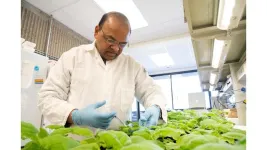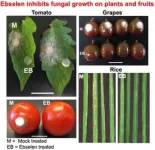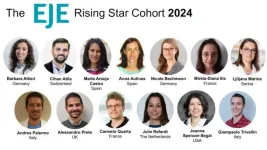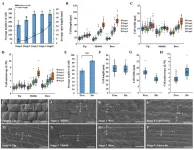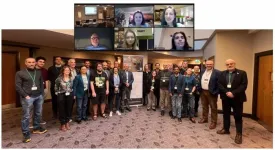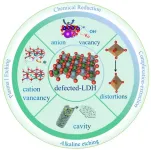(Press-News.org) A promising new fungicide to fight devastating crop diseases has been identified by researchers at the University of California, Davis. The chemical, ebselen, prevented fungal infections in apples, grapes, strawberries, tomatoes and roses and improved symptoms of pre-existing fungal infection in rice.
Fungal pathogens account for almost a quarter of global crop losses. In the United States, these losses amount to around $150 billion per year. However, fungicide development has been slow for the past 50 years, largely because researchers have had difficulty identifying molecular pathways to target. In a new study published Feb. 29 in Nature Communications, UC Davis researchers identified fungicide candidates that target autophagy, a cellular recycling process that was recently shown as essential for fungal pathogenicity.
Using a novel screening method based on bioluminescence, the researchers identified 30 chemicals that inhibit a key enzymatic step in fungal autophagy. The most promising candidate, ebselen, has been shown to have anti-inflammatory and neuroprotective properties in humans and was more effective at preventing in vitro fungal growth than currently available fungicides.
“Inhibiting autophagy significantly reduces the pathogenicity of several devastating fungal pathogens,” said senior author Savithramma Dinesh-Kumar, a professor and chair in the Department of Plant Biology. “Our findings provide molecular insights that will help to develop the next generation of antifungal compounds.”
A novel fungicide target
Autophagy is an essential process in fungi, plants and animal cells that enables them to recycle cellular components and remove toxic waste products. Because recent studies have shown that autophagy is involved in fungal pathogenicity, the researchers hypothesized that blocking autophagy would inhibit fungal infection. They set out to identify chemicals that inhibit autophagy in fungi, focusing on one key step in the pathway — the cleavage of the ATG8 protein by the enzyme ATG4.
To identify chemicals that inhibit this reaction, the team developed a test that allowed them to visualize when the reaction occurred and when it was blocked. Then, they tested the fungi’s ability to enzymatically cleave ATG8 in the presence of 2,700 different chemicals from a library of FDA-approved compounds. This method has advantages over other screening methods in that it allows a large number of chemicals to be tested very rapidly.
Altogether, the researchers identified 30 chemical compounds that inhibited cleavage and 14 compounds that enhanced cleavage. They selected the most effective inhibitor, ebselen, for further testing.
Protecting plants from fungal pathogens
In petri-dish experiments, ebselen prevented fungal germination and growth better than drugs that are on the market right now, Dinesh-Kumar said. The team also showed that ebselen prevented fungal infections in a range of plant species while demonstrating curative potential: When the researchers applied the chemical to the leaves of rice plants that were previously infected with rice blast fungus, it effectively eliminated infection.
“We think ebselen will primarily be useful for protecting plants against future infections, but it can also partially overcome existing infections if it is used early enough,” said Dinesh-Kumar.
Although the team’s preliminary testing indicates that ebselen specifically inhibits autophagy in fungi, more testing is needed to ensure its safety.
“Since autophagy is highly conserved across different organisms, including humans, more work needs to be done to test the cross reactivity of the drug,” said Dinesh-Kumar.
The UC Davis researchers also plan to use their screening method to test even more chemicals for their ability to inhibit autophagy.
“The chemical space is very large, and some chemical libraries have more than 50,000 compounds,” said Dinesh-Kumar. “The next step will be to screen for additional autophagy modulators that might help control not just plant fungal pathogens, but also human fungal pathogens.”
Additional authors on the study are: Tatiana V. Roubtsova, Celine Caseys, Dan Kliebenstein, and Richard M. Bostock, UC Davis; Jongchan Woo, Seungmee Jung, and Eunsook Park, University of Wyoming, Laramie; Martin B. Dickman, Honghong Zhang, and Yurong Li, Texas A & M University; Kyung-Nam Kim, Sejong University, Korea; and Seongbeom Kim, Hyunjung Chung, Yong-Hwan Lee and Doil Choi, Seoul National University, Korea.
The work was supported by the National Science Foundation, the Korea National Research Foundation, and the National Institutes of Health.
END
Plant biologists identify promising new fungicides
2024-02-29
ELSE PRESS RELEASES FROM THIS DATE:
Researchers uncover a potential genetic marker associated with better survival outcomes in patients with head and neck cancer
2024-02-29
FINDINGS
Researchers from the UCLA Health Jonsson Comprehensive Cancer Center show for the first time that a gene usually linked to giant axonal neuropathy, a rare and severe neurological condition, also plays a role in inhibiting aggressive tumor cell growth in head and neck cancers.
The team found when the specific genetic variant (GAN gene exon 8 SNP T allele) of the GAN gene isn't present, it leads to the production of certain proteins that make cancer cells more likely to spread and become resistant to treatment.
These findings suggest that the presence of the genetic variant and higher expression of the GAN gene product gigaxonin may contribute ...
European Society for Endocrinology’s European Journal of Endocrinology announces “Rising Stars” in endocrine research for 2024-26
2024-02-29
Thirteen exceptional endocrine researchers from across Europe and the US have been selected as the 2024-26 cohort of the EJE Rising Star Editorial Board by the European Journal of Endocrinology (EJE), a journal published by the European Society of Endocrinology (ESE).
This prestigious opportunity is given to individuals selected by EJE Editors who show promise, achievement and trajectory as leading clinical and translational researchers in endocrinology, with high potential to serve as future editors of EJE.
Through the Rising Stars Programme, awardees are granted the following:
membership ...
Hai-quan Huang's research team at Southwest Forestry University has revealed the cellular and molecular basis of the spur development in Impatiens uliginosa
2024-02-29
As an important reproductive organ of angiosperms, flowers have clear purposefulness and adaptive significance in their various characteristics. As a typical floral evolutionary feature, the floral spur is a tubular structure extending from the petal, which has undergone several independent evolutions in angiosperms (e.g., Impatiens, Aquilegia, Linaria, etc.). Meanwhile, it plays a vital role in the pollination process because of its properties of secreting and storing nectar. In addition, the morphology (length, diameter, degree of distortion), ...
New research reveals that lockdowns had an impact on gut microbes and allergies in newborns
2024-02-29
29 February 2024: Lockdowns imposed during the COVID-19 pandemic had an impact on the gut microbiome development of babies born during these periods according to new research from RCSI University of Medicine and Health Sciences, Children’s Health Ireland and APC Microbiome Ireland (APC), a world leading SFI Research Centre, based in University College Cork.
Our gut microbiome, an ecosystem of microbes that live in our digestive tract, plays an essential role in human health. The study published in Allergy is the first to specifically explore the gut health of newborns in the pandemic. ...
Seeing the wood for the trees: how archaeologists use hazelnuts to reconstruct ancient woodlands
2024-02-29
If we could stand in a landscape that our Mesolithic ancestors called home, what would we see around us? Scientists have devised a method of analyzing preserved hazelnut shells to tell us whether the microhabitats around archaeological sites were heavily forested or open and pasture-like. This could help us understand not only what a local environment looked like thousands of years ago, but how humans have impacted their habitats over time.
“By analyzing the carbon in hazelnuts recovered from archaeological sites in southern Sweden, from Mesolithic hunter-gatherer ...
EU-funded Biodiversity Community Integrated Knowledge Library (BiCIKL) project sums up outcomes and future prospects at a Final GA in Cambridge
2024-02-29
The city of Cambridge and the Wellcome Campus hosted the Final General Assembly of the EU-funded project BiCIKL (acronym for Biodiversity Community Integrated Knowledge Library): a 36-month endeavour that saw 14 member institutions and 15 research infrastructures representing diverse actors from the biodiversity data realm come together to improve bi-directional links between different platforms, standards, formats and scientific fields. Consortium members who could not attend the meeting in Cambridge joined the meeting remotely.
The ...
Detailed study demonstrates how pulse oximeters significantly overestimate oxygen readings in people with darker skin tones
2024-02-29
Pulse oximeters – one of the most common medical devices used in global healthcare – can provide significantly overestimated oxygen saturation readings in people with darker skin tones, according to the most comprehensive study ever to explore the issue.
Published in the British Journal of Anaesthesia, the new study is based on a systematic review of previous research into the use of the devices, and examined 44 studies dating from the mid-1970s to the present day.
In the course of that, researchers assessed more than 733,000 oxygen saturation readings taken from over 222,000 people – including almost ...
Virtual walking by synthesizing avatars into a 360-degree video
2024-02-29
Overview:
Researchers at the Toyohashi University of Technology and the University of Tokyo developed a system that provides a virtual walking experience to a seated person by real-time synthesis of a walking avatar and its shadow on a 360-degree video with vibrations to the feet. The shadow of the avatar induces an illusory presence of their body. In the future, it is expected to provide an immersive experience for any recorded medium with a virtual embodiment.
Details:
Walking is a fundamental activity for humans ...
How to make difficult-to-cut materials and components “easy-to-cut”?
2024-02-29
Difficult-to-cut materials such as titanium alloys, high-temperature alloys, metal/ceramic/polymer-matrix composites, hard and brittle materials, as well as geometrically complex components such as thin-walled structures, micro channels and complex surfaces, are widely used in aerospace community. Nevertheless, many problems including severe and rapid tool wear, low machining efficiency, and poor surface integrity exist in mechanical machining. How to efficiently and precisely process these materials and components, i.e., make difficult-to-cut ...
Defects engineering of layered double hydroxide-based electrocatalyst for water splitting
2024-02-29
In the context of the gradual depletion of fossil fuels and the energy crisis, hydrogen energy has attracted widespread attention due to its ultra-high energy density and eco-friendly properties. However, most of the hydrogen production still relies on fossil fuels, with less than 1 million tonnes produced as low-emission hydrogen in 2021, which means it has limited benefits in mitigating the energy crisis and environmental degradation. Alternatively, hydrogen production via water electrolysis has the advantages ...
